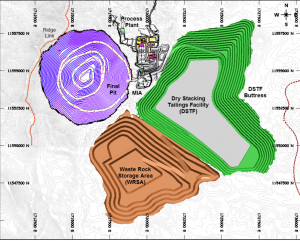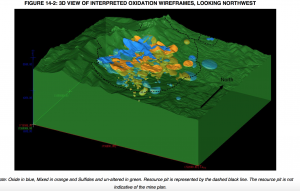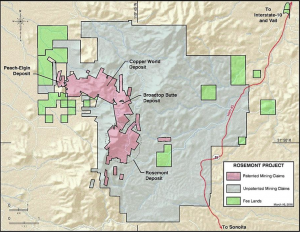Toronto-based Hudbay Minerals Inc. has identified an additional 591 million tons of copper-bearing rock in deposits adjacent to its proposed mile-wide, half-mile deep Rosemont open pit copper mine that it says could be economically mined in the future.
The additional resources were disclosed in a March 31 feasibility study required by Canadian regulators and used to obtain financing for the project. The disclosure of additional resources equal to what the company already plans to extract from the pit mine raises questions about the scope and lifespan of the project and resulting adverse impacts.
The currently proposed Rosemont pit is located within a larger area the technical report defines as the “resource pit shell.” The resource pit shell extends over the Santa Rita’s ridgeline and down the western slope. The additional 591 million tons of mineralized rock lies outside the Rosemont pit but within the resource pit shell.
The Rosemont mine would be constructed on the northeastern flank of the Santa Rita Mountains on the Coronado National Forest southeast of Tucson. The mining would generate 1.25 billion tons of waste rock and mine tailings. Hudbay intends to dump the waste into 700-foot high “earthforms” spread across 3,000 acres of national forest.
The feasibility study also raises the estimated cost of constructing the mine complex to $1.9 billion, up 21 percent from the company’s $1.5 billion projection made in Feb. 2015. Augusta Resource, the previous owner of the Rosemont site, estimated the mine would cost $1.2 billion in 2012 and $890 million in 2009.
Hudbay’s current plans call for mining 592 million tons of ore from the open pit that would contain 5.3 billion pounds of copper, 142 million pounds of molybdenum and 79 million ounces of silver. The company states it plans to process 90,000 tons of ore per day and produce an average of 279 million pounds of copper per year over the estimated 19-year life of the pit.

(Click on the graphic to enlarge.) The Rosemont Mine site after 19 years of open pit mining is completed.
The possibility that Hudbay could mine up to an additional 591 million tons of copper-bearing rock after mining in the pit is completed raises questions of where the waste rock and tailings would be deposited. Expanding the footprint of the mine would also have significant impacts on water resources and the landscape that hosts a dozen threatened and endangered species and the economic impacts that will follow (e.g., water resources, ecotourism).
Complex environmental studies including the Environmental Impact Statement and the numerous state and federal permits have been based on Hudbay’s plans to develop the open pit mine. The permits and environmental studies do not include the potential impacts of additional mining outside of the Rosemont pit.

(Click on the graphic to enlarge.) The dotted line encompasses the resource pit shell. The actual Rosemont pit would be constructed within the the resource pit shell.
The technical report states the copper-bearing rock has the “potential for economic extraction after the current mineral reserves estimate (the ore located within the pit) has been mined and processed.”
The report does not identify the exact location of the additional resources outside the proposed pit, nor does it provide a plan of how the copper-bearing rock would be mined.
The feasibility study states the economic value of mineral resource estimates can be impacted by a number of factors including:
- Long-term commodity price assumptions
- Operating cost assumptions
- Metal recovery assumptions
- Changes to the tonnage and grade estimates may vary as a result of more drilling, new assay, and tonnage factor information.
The current mining plan is projected to initially employ 337 workers in the pre-production period increasing to a maximum of 459 employees in year seven.
Hudbay states it expects to use 6,000 acre-feet of water per year (an acre-foot equals 325,581 gallons) pumped from wells adjacent to the Santa Cruz River. The water would be sent through a pipeline to the mine site where processing facilities will use water at a rate of 3,500 gallons to 5,000 gallons per minute.

(Click on the graphic to enlarge.) Hudbay owns mining patents for major copper deposits including Rosemont, Broadtop Butte, Copper World and Peach Elgin.
Based on an average copper price of $3/pound, Hudbay states the Rosemont mine will generate $13.4 billion in revenue over the life of the mine. After all expenses, including $718 million in taxes, the company expects to generate $2.903 billion in “after-tax free cash flow.”
Hudbay still needs a Clean Water Act permit issued by the U.S. Army Corps of Engineers and final approval from the Coronado National Forest before construction could begin. The Army Corps’ district office recommended denial of the Section 404 CWA permit last July. A final decision is expected later this year.

8 Responses to Hudbay identifies major deposits with economic potential adjacent to its proposed Rosemont open pit copper mine